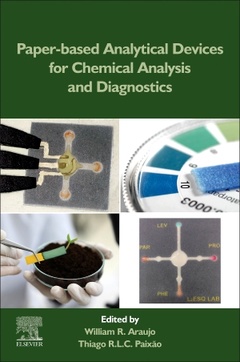Paper-Based Analytical Devices for Chemical Analysis and Diagnostics
Coordonnateurs : de Araujo William R., Paixao Thiago R.L.C.

1. Introduction remarks for paper-based analytical devices and timeline
2. Chemistry of paper - properties, modification strategies and uses in bioanalytical chemistry
3. Paper-based separation devices
4. Colorimetric Paper-based analytical devices
5. Electrochemical Paper-based analytical devices
6. Surface-Enhanced Raman Scattering Paper-based analytical devices
7. Chemiluminescence Paper-based analytical devices
8. Fluorescence Paper-based analytical devices
9. Electrochemiluminescence Paper-Based analytical devices
10. Paper-based immunoassays for mobile healthcare: strategies, challenges and future applications
11. Conclusion, challenges and next steps
Thiago R.L.C. Paixão received a BSc (2001), MSc (2004), and PhD (2007), followed by a postdoctoral fellowship between 2008 and 2009 working with electronic tongue devices at the Institute of Chemistry of the University of São Paulo. He was then appointed as an Assistant Professor at the University Federal of ABC where he stayed for two years. In 2011, he was hired as an assistant professor at the University of São Paulo and promoted to Associate Professor in 2016. In the beginning of 2018, he was nominated as affiliate member of the Brazilian Academy of Science as a young promising researcher. His fields of interest include chemical sensors, paper-based devices, and electronic tongues aiming at forensic and clinical applications.
- Reviews the evolution of this area and offers predictions for the future of the field of paper-based analytical devices
- Explores the analytical techniques used in development of paper-based devices
- Discusses challenges and shortcomings specific to each type of device, helping users and developers to avoid pitfalls
Date de parution : 10-2021
Ouvrage de 298 p.
15x22.8 cm
Thème de Paper-Based Analytical Devices for Chemical Analysis and... :
Mots-clés :
Additives; Aptamers; Biosensors; Cellulose; Cellulose-based material; Challenges; Chemical modification; Chemiluminescence; Colorimetric reaction; Commercialization; Digital camera; Drawbacks; EPADs; Electrochemical sensors; Electrochemiluminescence; Electrogenerated chemiluminescence; Enhancement nanostructures; µPADs; “turn-on/off fluorescence; Fabrication process; Fluorescent materials; Immunosensors; Lab-on-a-chip; Lateral flow assays; Low-cost platforms; Medical healthcare; Microfluidic devices; Microfluidic paper-based analytical device; Microfluidics; Miniaturized detectors; Mobile device; Nanomaterials; Paper; Paper as a substrate for sensors; Paper chromatography; Paper devices; Paper electrophoresis; Paper fabrication; Paper material; Paper microfluidics; Paper-based analytical devices; Paper-based devices; Paper-based immunoassay; Perspectives; Point-of-care; Point-of-care diagnostics; Point-of-need devices; Portable detector; Portable devices; Raman; Ratiometric fluorescence; SERS; Screen printing; Sensing paper; Sensors; Smartphone; Spectroscopy; Thermal; Wax patterning



